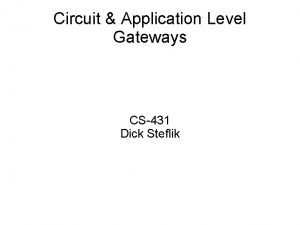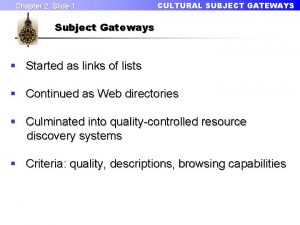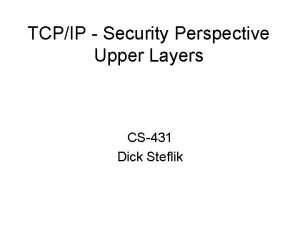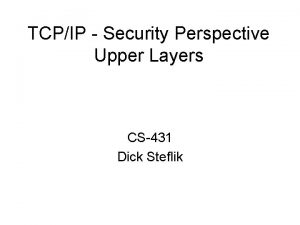Circuit Application Level Gateways CS431 Dick Steflik Application













- Slides: 13

Circuit & Application Level Gateways CS-431 Dick Steflik

Application Level Gateways ● Also called a Proxy Firewall ● Acts as a relay for application level traffic Typical applications: ● ● ● Telnet FTP SMTP HTTP More secure than packet filters Bad packets won't get through the gateway Only has to deal with application level packets Simplifies rules needed in packet filter

● ● ● Client connects Gateway does in depth inspection of the application level packet, if connection meets criteria on the gateway rule base packet will be proxied to the server Proxy firewall is directly between the client and the server on an application by application basis

ALG Use ● ● Many application clients can be configured to use a specific ALG (proxy) by the end user Firefox-Options-Advanced-Network-Connections. Proxy WS/FTP-Connect-Firewall-Proxy Router can be set to forward all application packets to specific proxy Benefit is all user traffic is forced to a proxy User cannot bypass the proxy

Additional ALG Benefits ● Privacy Outside world only sees the IP of the gateway not the IPs of the end users Prevents foreign hosts from harvesting user addresses for later use in SPAM ● ● Especially important for HTTP Ideal place to do logging

Circuit Level Gateways ● Also known as a Stateful Inspection Firewall ● Session layer of OSI ● ● Shim between transport and application layer of TCP/IP Monitors handshake used to establish connections ● Hides information about internal network ● Breaks the TCP connection Proxies the TCP connection

SOCKS (SOCKet. S) ● RFC 1928 ● Generic proxy protocol for TCP/IP ● ● Provides a framework for developing secure communications by easily integrating other security technologies Works for both TCP and UDP (ver. 5)

How Does SOCKS Work ● ● Client wants to connect to an application server Connects to SOCKS proxy using SOCKS protocol SOCKS proxy connects to application server using SOCKS protocol To the application server the SOCKS server is the client

SOCKS Client SOCKS Application SOCKS Client Transport Physical App Server Application Transport Physical

The SOCKS Protocol ● SOCKS ver 5 IETF Approved (RFC 1928) ● Two components ● Client – sits between the Application and Transport layers Server – application layer Purpose is to enable a client on one side of the SOCKS server to talk to a server on the other side without requiring IP reachability

SOCKS Functions ● Make Connection Requests ● Set up proxy circuits ● Relay Application Data ● Perform user authentication

SOCKS Features ● Transparent network access across multiple proxy servers ● Easy deployment of authentication and encryption ● Rapid deployment of new network applications ● Simple network security policy management

SOCKS Benefits ● Single protocol authenticates and establishes the communication channel ● Is application independent ● Can be used with TCP or UDP ● Supports redirection of ICMP Bi-directional support and intrinsic NAT for added security and anti-spoofing
 Circuit-level gateways
Circuit-level gateways Application level gateways
Application level gateways Robert stevenson director
Robert stevenson director Cisco pstn
Cisco pstn Behavior management middleware
Behavior management middleware Gateways to art: understanding the visual arts
Gateways to art: understanding the visual arts Pfa compliance checklist
Pfa compliance checklist Subject gateways example
Subject gateways example Bpmn gateways
Bpmn gateways Tdm pstn
Tdm pstn Protocol gateways
Protocol gateways Protocol gateways
Protocol gateways Series vs paralle
Series vs paralle Types of electrical circuits
Types of electrical circuits

























